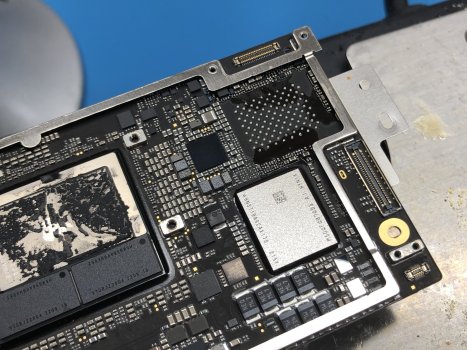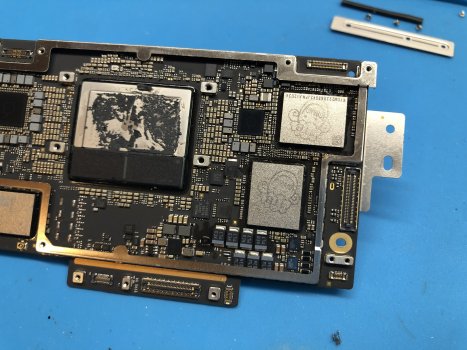In this thread, we intend to share all relevant details, resources, and processes involved with upgrading soldered storage on Apple Silicon Macs.
Notes
Supported NAND configurations for regular M1 / M2 / M3 /M4
Supported NAND configurations for M1 / M2 / M3 /M4 Pro, Max and Ultra
To complete these upgrades most effectively, the best option is to try and locate brand new, "blank" chips to install. In such instance, all you need to do is solder on the new chips onto any NAND landing pad on the desired board, DFU restore, and that's it. Technically, only NAND0 (master NAND) needs to be blank, or in the case of utilizing an 8 NAND config on M1 Pro/Max/Ultra, the master NAND of each channel/port needs to be blank.
If you cannot locate blank chips, and don't have a matched pre-programmed set to simply transfer over, you will need to program them yourself before installation using JC P13, P15, or LB H7 programmer. To do so, you will need appropriate dumps for your desired config, specific to the desired NANDs. This thread will also serve as a place to share such dumps. The dumps I have currently are linked below:
Notes
- All M1 systems utilize BGA110 "S5E" NANDs
- Some M2 systems use BGA110, while some use BGA315
Supported NAND configurations for regular M1 / M2 / M3 /M4
| Model | Disk Brand | 256GB | 512GB | 1TB | 2TB |
|---|---|---|---|---|---|---|
M1 BGA110 | A2337 MBA 13" A2338 MBP 13" A2348 Mini M1 A2438 iMac A2439 iMac | Kioxia Hynix Sandisk | 1xKICM232 1xKICM225 2x HN3T0BA2 - | 1xKICM233 1xKICM227 - - | 2x KICM229 2x H23B4T84 2x SDREGJHIH | 2x KICM223 2x 2xH23B8T85 2x SDSFGJLKH |
M2 BGA110 | A2681 MBA 13" A2338 MBP 13" | Kioxia Hynix Sandisk | 1xKIC5224 1xHN3T1BA4 - | 2xKIC5224 2xHN3T1BA4 - | 2xKIC5226 2xHN3T2BA8 - | 2x KIC5228 2xHN3T3BAG - |
M2 BGA315 | A2941 MBA 15" A2686 Mini M2 | Kioxia Hynix Sandisk | 1x K5A4 1x HN3T1AA2 1x SDSFGKLX4 | 2x K5A4 2x HN3T1DT4 - | 2x K5A5 2x HN3T2DT8 - | 2x K5A8 2x HN3T3 - |
M3 BGA315 | A3113 MBA 13" A3114 MBA 15" A2873 iMac A2874 iMac A2918 MBP 14" | Kioxia Hynix Sandisk | 2x K5A3 2x HN3T0AA2 - | 2x K5A4 2x HN3T1DT4 - | 2x K5A5 2x HN3T2DT8 - | 2x K6B2 2x HN3T3DTG - |
M4 BGA315 | A3240 MBA 13" A3241 MBA 15" A3112 MBP 14" A3238 Mini M4 A3137 iMac A3247 iMac | Kioxia Hynix Sandisk | 2x K5A3 - - | 2x K5A4 - - | 2x K5A5 - - | 2x K6B2 or K5A8 - 2x SDSFGKLKH |
Supported NAND configurations for M1 / M2 / M3 /M4 Pro, Max and Ultra
| Model | Disk Brand | 512GB | 1TB | 2TB | 4TB | 8TB | 16TB |
|---|---|---|---|---|---|---|---|---|
M1 Pro M1 Max M1 Ultra BGA110 | A2442 A2485 A2601 | Kioxia Hynix Sandisk | 1xKICM232 3xKICM225 - - | 1xKICM233 3xKICM227 - - | 4x KICM229 4x H23B4T84 4x SDREGJHIH | 8x KICM229 8x H23B4T84 8x SDREGJHIH | 8x KICM223 8x 2xH23B8T85 8x SDSFGJLKH | X |
M2 Pro M2 Max M2 Ultra BGA315 | A2442 A2485 A2901 Mac Studio A2786 Mac Pro | Kioxia Hynix Sandisk | 2x K5A4 2x HN3T1AA2 2x SDSFGKLX4 | 4x K5A4 4x HN3T1AA2 4x SDSFGKLX4 | 4x K5A5 4x HN3T2DT8 - | 8x K5A5 8x HN3T2DT8 - | 8x K5A8 8x HN3T3 - | X |
M4 Pro BGA315 | A3401 MBP 14" A3403 MBP 16" A3289 Mini M4 Pro | Kioxia Hynix Sandisk | 4x K5A3 - - | 4x K5A4 - - | 4x K5A5 - - | 4x K6B2 - - | 4x K6B3 - - | X |
M3 Pro M3 Max M4 Max BGA315 | A2992 MBP 14" A2991 MBP 16" A3185 MBP 14" A3186 MBP 16" A3143 Mac Studio | Kioxia Hynix Sandisk | 4x K5A3 - - | 4x K5A4 - 4x HN3T1DT4 | 4x K5A5 - 4x HN3T2DT8 | 8x K5A5 - 8x HN3T2DT8 | 8x K6B2 - 8x HN3T3DTG | X |
M3 Ultra BGA315 | A3389 Mac Studio | Kioxia Hynix Sandisk Samsung | X | 4x K5A4 - 4x HN3T1DT4 - | 4x K5A5 - 4x HN3T2DT8 - | 8x K5A5 - 8x HN3T2DT8 - | 8x K6B2 - 8x HN3T3DTG - | 8x K6B3 - - 8x KLBIGAN5 |
( table courtesy of @gilles_polysoft )
- Standard M1
- 2TB: 2x KICM223
- 1TB: 2x KICM229
- M1 Pro/Max/Ultra:
- 2TB: 4x KICM229
- 4TB: 8x KICM229 (requires adding missing components to use other 4 NAND landing pads)
- 8TB: 8x KICM223
To complete these upgrades most effectively, the best option is to try and locate brand new, "blank" chips to install. In such instance, all you need to do is solder on the new chips onto any NAND landing pad on the desired board, DFU restore, and that's it. Technically, only NAND0 (master NAND) needs to be blank, or in the case of utilizing an 8 NAND config on M1 Pro/Max/Ultra, the master NAND of each channel/port needs to be blank.
If you cannot locate blank chips, and don't have a matched pre-programmed set to simply transfer over, you will need to program them yourself before installation using JC P13, P15, or LB H7 programmer. To do so, you will need appropriate dumps for your desired config, specific to the desired NANDs. This thread will also serve as a place to share such dumps. The dumps I have currently are linked below:
- 2x KICM223 2TB config (for any standard M1 Mac, including MacBook Pro, Air, Mac Mini, etc. Tested and known working(courtesy of @gilles_polysoft)
- 4x KICM229 2TB config (for any M1 Pro/Max/Ultra system. Untested, but includes dumps of known-blank chips, which may be usable to revert a programmed KICM229 back to a "blank" state)
Last edited:




